
The Dutch West India Company was a chartered company of Dutch merchants as well as foreign investors. Among its founders was Willem Usselincx (1567–1647) and Jessé de Forest (1576–1624). On 3 June 1621, it was granted a charter for a trade monopoly in the Dutch West Indies by the Republic of the Seven United Netherlands and given jurisdiction over Dutch participation in the Atlantic slave trade, Brazil, the Caribbean, and North America. The area where the company could operate consisted of West Africa and the Americas, which included the Pacific Ocean and the eastern part of New Guinea. The intended purpose of the charter was to eliminate competition, particularly Spanish or Portuguese, between the various trading posts established by the merchants. The company became instrumental in the largely ephemeral Dutch colonization of the Americas in the seventeenth century. From 1624 to 1654, in the context of the Dutch-Portuguese War, the GWC held Portuguese territory in northeast Brazil, but they were ousted from Dutch Brazil following fierce resistance.

The Dutch East India Company, officially the United East India Company, was a megacorporation founded by a government-directed consolidation of several rival Dutch trading companies (voorcompagnieën) in the early 17th century. It is believed to be the largest company to ever have existed in recorded history. It was established on March 20th 1602, as a chartered company to trade with Mughal India in the early modern period, from which 50% of textiles and 80% of silks were imported, chiefly from its most developed region known as Bengal Subah. In addition, the company traded with Indianised Southeast Asian countries when the Dutch government granted it a 21-year monopoly on the Dutch spice trade.

The Atlantic slave trade, transatlantic slave trade, or Euro-American slave trade involved the transportation by slave traders of various enslaved African people, mainly to the Americas. The slave trade regularly used the triangular trade route and its Middle Passage, and existed from the 16th to the 19th centuries. The vast majority of those who were enslaved and transported in the transatlantic slave trade were people from Central and West Africa, who had been sold by other West Africans, or by half-European "merchant princes" to Western European slave traders, who brought them to the Americas. Except for the Portuguese, European slave traders generally did not participate in the raids because life expectancy for Europeans in sub-Saharan Africa was less than one year during the period of the slave trade. The South Atlantic and Caribbean economies were particularly dependent on labour for the production of sugarcane and other commodities. This was viewed as crucial by those Western European states that, in the late 17th and 18th centuries, were vying with each other to create overseas empires.
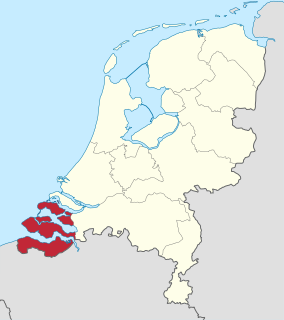
Zeeland is the westernmost and least populous province of the Netherlands. The province, located in the south-west of the country, borders North Brabant to the east, South Holland to the north, and the country of Belgium to the south and west. It consists of a number of islands and peninsulas and a strip bordering the Flemish provinces of East and West Flanders. Its capital is Middelburg with a population of 48,544 as of November 2019, the largest municipality in Zeeland is Terneuzen. Zeeland has two seaports: Vlissingen and Terneuzen. Its area is 2,934 square kilometres (1,130 sq mi), of which 1,151 square kilometres (440 sq mi) is water, and it has a population of 383,689 as of November 2019.

The Dutch colonization of the Americas began with the establishment of Dutch trading posts and plantations in the Americas, which preceded the much wider known colonization activities of the Dutch in Asia. While the first Dutch fort in Asia was built in 1600, the first forts and settlements along the Essequibo River in Guyana date from the 1590s. Actual colonization, with the Dutch settling in the new lands, was not as common as with other European nations. Many of the Dutch settlements were lost or abandoned by the end of the 17th century, but the Netherlands managed to retain possession of Suriname until it gained independence in 1975. Among its several colonies in the region, only the Dutch Caribbean still remains to be part of the Kingdom of the Netherlands today.

Middelburg is a city and municipality in the south-western Netherlands serving as the capital of the province of Zeeland. Situated on the central peninsula of the Zeeland province, Midden-Zeeland, it has a population of about 48,000.
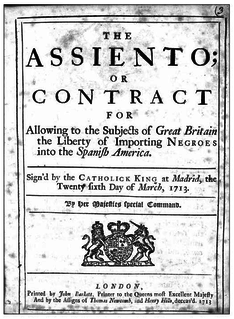
The Asiento de Negros was a monopoly contract between the Spanish Crown and various merchants for the right to provide African slaves to colonies in the Spanish Americas. The Spanish Empire rarely engaged in the trans-Atlantic slave trade directly from Africa itself, choosing instead to contract out the importation to foreign merchants from nations more prominent in that part of the world; typically Portuguese and Genovese, but later the Dutch, French and British. The Asiento did not concern French or British Caribbean but Spanish America. The 1479 Treaty of Alcáçovas divided the Atlantic Ocean and other parts of the globe into two zones of influence, Spanish and Portuguese. The Spanish acquired the west side washing South America and the West Indies, whilst the Portuguese obtained the east side washing the west coast of Africa - and also the Indian Ocean beyond. The Spanish relied on African slave labour to make their American colonial project possible, but now lacked any trading or territorial foothold in West Africa, the principal source of slave labour. Thus the Spanish were reliant on Portuguese slave traders for all their requirements. The contract was usually obtained by foreign merchant banks who cooperated with local or foreign traders, specialized in shipping. Different organisations and individuals would bid for the right to hold the asiento.

The Dutch colonial empire comprised the overseas territories and trading posts controlled and administered by Dutch chartered companies—mainly the Dutch West India Company and the Dutch East India Company—and subsequently by the Dutch Republic (1581–1795), and by the modern Kingdom of the Netherlands after 1815. It was initially a trade-based system which derived most of its influence from merchant enterprise and from Dutch control of international maritime shipping routes through strategically placed outposts, rather than from expansive territorial ventures. The Dutch were among the earliest empire-builders of Europe, following Spain and Portugal.

The Dutch Gold Coast or Dutch Guinea, officially Dutch possessions on the Coast of Guinea was a portion of contemporary Ghana that was gradually colonized by the Dutch, beginning in 1612. The Dutch began trading in the area around 1598, joining the Portuguese which had a trading post there since the late 1400s. Eventually, the Dutch Gold Coast became the most important Dutch colony in West Africa after Fort Elmina was captured from the Portuguese in 1637, but fell into disarray after the abolition of the slave trade in the early 19th century. On 6 April 1872, the Dutch Gold Coast was, in accordance with the Anglo-Dutch Treaties of 1870–71, ceded to the United Kingdom.

Loango-Angola is the name for the possessions of the Dutch West India Company in contemporary Angola and the Republic of the Congo. Notably, the name refers to the colony that was captured from the Portuguese between 1641 and 1648. Due to the distance between Luanda and Elmina, the capital of the Dutch Gold Coast, a separate administration for "Africa South" was established at Luanda during the period of the Dutch occupation.

The Noordsche Compagnie was a Dutch cartel in the whaling trade, founded by several cities in the Netherlands in 1614 and operating until 1642. Soon after its founding, it became entangled in territorial conflicts with England, Denmark, France, and other groups within the Netherlands.

The Slave Route Project is a UNESCO initiative that was officially launched in 1994 in Ouidah, Benin. It is rooted in the mandate of the organization, which believes that ignorance or concealment of major historical events constitutes an obstacle to mutual understanding, reconciliation and cooperation among peoples. The project breaks the silence surrounding the slave trade and slavery that has affected all continents and caused great upheavals that have shaped our modern societies. In studying the causes, the modalities and the consequences of slavery and the slave trade, the project seeks to enhance the understanding of diverse histories and heritages stemming from this global tragedy.

The Dutch Slave Coast refers to the trading posts of the Dutch West India Company on the Slave Coast, which lie in contemporary Ghana, Benin, Togo and Nigeria. The primary purpose of the trading post was to supply slaves for the plantation colonies in the Americas. Dutch involvement on the Slave Coast started with the establishment of a trading post in Offra in 1660. Later, trade shifted to Ouidah, where the English and French also had a trading post. Political unrest caused the Dutch to abandon their trading post at Ouidah in 1725, now moving to Jaquim, at which place they built Fort Zeelandia. By 1760, the Dutch had abandoned their last trading post in the region.
The history of the Dutch economy has faced several ups and downs throughout the 16th and 17th centuries. It has undergone moments of prosperity and was one of the dominant world powers in the 17th Century. Its heavy involvement in the Atlantic Trade had a large impact on its economy and growth. There is no clear definition for the Atlantic Trade, but researchers have concluded it may be referred to as: Trade with the New World, and trade with Asia through the Atlantic including, but not limited to, imperialism and slavery based undertakings. Among the most important of these traders were the Dutch and the British. It is noted that these two nations experienced a more rapid growth than most due to their non-absolutist political institutions. This is only one of many beneficial factors that played a role in shaping growth and economic change within the Netherlands that occurred throughout the 16th and 17th centuries.
The Anglo-Dutch Slave Trade Treaty was a treaty signed between the United Kingdom and the Kingdom of the Netherlands signed on 4 May 1818, aimed at preventing slave trade carried out through Dutch vessels. The treaty allowed both parties to search vessels of the other for on-board slaves. Among other things, the treaty established two Mixed Commission Courts, one with a seat in Freetown, Sierra Leone and another in Paramaribo, Suriname, which had the power to sentence slavers.
Balthazar de Moucheron was a Dutch trader, ship owner and one of the founders of the Dutch East India Company, but never participated as he went bankrupt in the same year. He is known for his early trading with India (Calcutta) and Indonesia, America, the west coast of Africa, the Baltic Sea and the White Sea (Archangelsk).
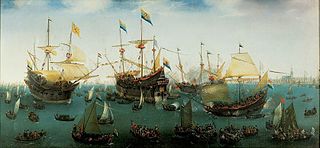
The Compagnie van De Moucheron was a pre-company and precursor of the Verenigde Oost Indische Compagnie from the Republic of the Seven United Netherlands that was founded by Balthazar de Moucheron, a ship owner from Antwerp in the Southern Netherlands. After the fall of Antwerp he moved his business to Zeeland. The fleet of the Compagnie van De Moucheron was made up of three ships, 'Ram', 'Schaap' (Sheep) and the pinasse 'Lam' (Lamb) and was headed by Joris van Spilbergen. Its fleet left on 5 May 1601 and returned to the Republic of the Seven United Netherlands in 1604.
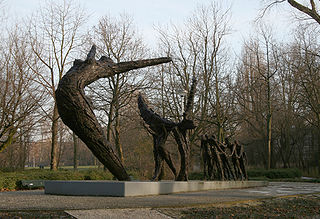
The History of Dutch slavery talks about slavery in the Netherlands itself, as well as the establishment of slavery outside the Netherlands in which it played a role.
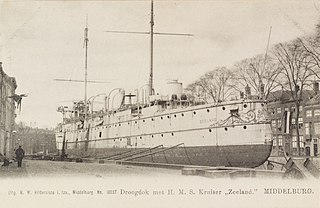
Middelburg Drydock is a former dry dock in Middelburg, Netherlands. The Dock chamber still exists.














